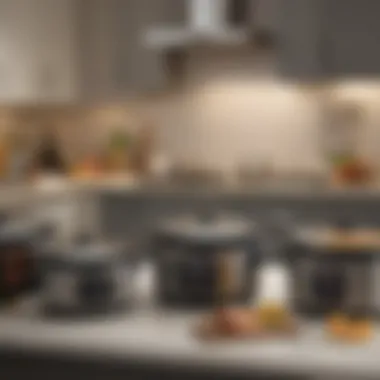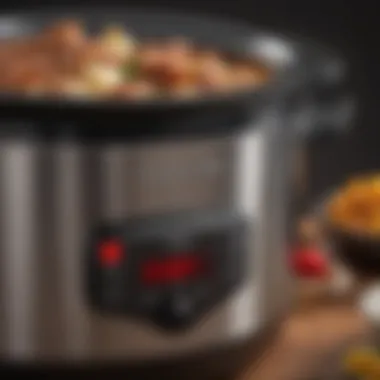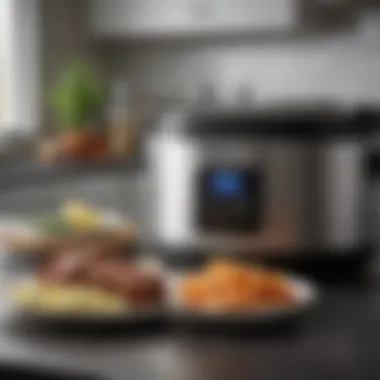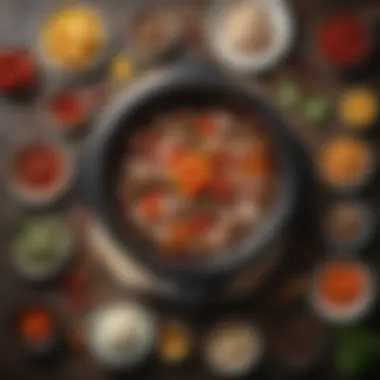Choosing the Right Slow Cooker: A Comprehensive Guide


Intro
Slow cookers have become an essential appliance in many kitchens. They offer a unique way to prepare meals with minimal effort, allowing flavors to meld together over time. This guide will help you choose the right slow cooker by examining key factors. Knowing the right slow cooker can make a significant difference in your cooking experience.
Understanding the features, sizes, and brand reputation is critical. It ensures that you purchase a model that meets your needs and fits your cooking style. Care and maintenance also play vital roles in maximizing the lifespan of your slow cooker.
Buy the right appliance today can save you time and effort in the kitchen, helping you to create delicious meals with ease.
Preamble to Slow Cookers
Slow cookers have become a staple in many kitchens. They offer convenience and versatility to both novice and experienced cooks. This section serves as an introduction to slow cookers, detailing their benefits and considerations for potential buyers. Understanding slow cookers is essential because they simplify meal preparation, allowing flavors to meld over time.
Often, busy lifestyles limit the amount of time people can spend in the kitchen. With slow cookers, you can prepare meals in advance, allowing for home-cooked food with minimal effort at the end of a long day. This article will explore various aspects of slow cookers to help you make an informed purchase.
What is a Slow Cooker?
A slow cooker is a countertop electric cooking appliance. It cooks food at low temperatures over an extended period. The design usually consists of a ceramic or stoneware pot that sits inside a metal housing. Most slow cookers use a simple on/off switch, while some have several temperature settings.
Slow cookers provide an even heat distribution, which helps enhance flavors in soups, stews, and braised dishes. This method of cooking allows ingredients to tenderize and maintain moisture without constant supervision. Such qualities make slow cookers an ideal choice for those looking for easy yet delicious meals.
Historical Background
The slow cooker has its roots in traditional cooking methods where meats and vegetables were cooked slowly to maximize flavor. The first electric slow cooker, the Crock-Pot, was introduced in the 1970s. Its convenience quickly caught on, particularly among working families. As people grew busier, the slow cooker became more popular.
Since then, many innovations have transformed the slow cooker market. Modern slow cookers often come with programmable settings and various functions. This evolution has allowed slow cooking to integrate seamlessly into a variety of culinary styles, enriching the cooking experience.
Overall, slow cookers represent an essential evolution in home cooking. They combine time-saving convenience with the ability to create complex flavors, making them a valuable addition to any kitchen.
Types of Slow Cookers
Understanding the various types of slow cookers is crucial for making an informed decision. Each type comes with its own characteristics that can significantly affect your cooking experience. By exploring these differences, you can pinpoint the slow cooker that aligns best with your culinary preferences and lifestyle. The right cooker can enhance meal preparation while ensuring optimal cooking results.
Traditional Slow Cookers
Traditional slow cookers are the most recognizable type. They have a simple design, usually featuring a ceramic or stoneware insert housed within a metal shell. This kind of slow cooker cooks food evenly and gently, making it ideal for stews, soups, and casseroles.
- Ease of Use: They are straightforward, typically with a couple of heat settings, which makes them user-friendly for beginners.
- Flavor Development: Slow, even cooking allows flavors to meld beautifully, enhancing the final dish.
- Versatility: Many traditional slow cookers have a removable insert, allowing for easy serving and cleaning.
However, these cookers lack advanced features found in newer models, which may limit cooking options.
Multi-Functional Cookers
Multi-functional cookers are at the forefront of modern kitchen appliances. These versatile machines not only slow cook but can also pressure cook, sauté, steam, and even bake.
- Space-Saving: By consolidating multiple cooking methods into one appliance, these cookers save valuable kitchen space.
- Convenience: They often come with numerous presets making them easier to use for various recipes.
- Efficiency: Multi-functional cookers generally cook meals faster than traditional slow cookers, thanks to their pressure cooking feature.
Yet, with the multitude of options and features, they may require a learning curve for new users.
Programmable Slow Cookers
Programmable slow cookers add a layer of sophistication and control to meal preparation. They come equipped with digital displays and timers that allow users to set cooking times in advance.


- Customization: You can program the cooker to start and stop cooking at specific times, ensuring that meals are ready when you are.
- Flexibility: Many models come with settings for high and low temperature cooking, accommodating various recipes and personal preferences.
- Consistency: The precision of programmable features ensures consistent results with each dish.
On the downside, they can be more expensive than traditional models and may require a bit of technological familiarity.
Pressure Cookers with Slow Cooking Function
Recently, pressure cookers that include a slow cooking function have become popular. These appliances provide the benefits of both cooking styles in one unit.
- Time-Saving: The pressure cooking option can prepare meals much faster compared to traditional methods.
- Flexibility: You can utilize the slow cooking function for dishes that benefit from prolonged cooking times while having the option to pressure cook when short on time.
- Quality of Cooking: The recipient of steam during pressure cooking can yield moist and flavorful dishes.
However, the initial complexity of usage may deter some individuals who prefer simplistic approaches to cooking.
Ultimately, understanding the different types of slow cookers is vital for selecting one that meets your culinary needs and lifestyle preferences. Each type offers distinct features and benefits, shaping how you experience meal preparation in your kitchen.
Key Features to Consider
When selecting a slow cooker, understanding its key features is crucial for ensuring it meets your cooking requirements. Each feature contributes significantly to performance, convenience, and durability. This section covers the essential elements that can enhance the slow cooking experience and optimize results.
Size and Capacity
The size and capacity of a slow cooker primarily determine its suitability for different households and occasions.
Small
Small slow cookers generally have a capacity of about 1.5 to 3 quarts. They are ideal for individuals or small families, allowing the preparation of smaller meals. A key characteristic is their compact design, which makes them easy to store and transport. The benefit of a small slow cooker is evident when cooking for one or two people, as they prevent waste by cooking just the right amount. However, one disadvantage is that they may not accommodate larger recipes, like stews or casseroles that serve more than a few people.
Medium
Medium slow cookers typically range from 3 to 5 quarts in capacity. This size is versatile and caters to families of up to four members. They are popular due to their ability to handle standard recipes without overflowing. A unique feature of the medium slow cooker is its balance between size and efficiency. It allows for cooking a variety of meals, from soups to roasts. The only drawback is that they may still feel cramped when preparing for gatherings or larger gatherings.
Large
Large slow cookers boast a capacity of over 5 quarts, reaching up to 8 quarts or more. These are particularly beneficial for cooking for larger families or for meal prepping in bulk. Their key characteristic is their ample space, which makes them capable of handling big dishes. A significant advantage is the ability to make hearty meals in a single pot, reducing the need for multiple cooking devices. One potential disadvantage is their size, which may make storage impractical in smaller kitchens.
Material and Insulation
Material and insulation play vital roles in a slow cooker’s performance and durability. Slow cookers often come in different materials, including ceramic, stainless steel, and non-stick surfaces. Ceramic pots typically provide even heat distribution, enhancing cooking quality. Stainless steel options are durable and enduring, while non-stick surfaces facilitate easy cleaning. Good insulation ensures that heat is retained within the pot, enabling efficient cooking. A well-insulated cooker will maintain consistent temperatures, which is essential for slow cooking.
Temperature Control Settings
Temperature control settings are crucial for achieving optimal results when cooking. Most slow cookers offer low, medium, and high settings, allowing for flexibility in cooking times. Some models come with additional options like a keep-warm setting. The ability to adjust temperature settings affects the cooking process, ensuring that dishes are prepared adequately without burning or undercooking. This feature is particularly important for precision cooking and versatility in meal preparation.
Timer and Delay Features
Timers and delay features add a layer of convenience in slow cooking. Many models now include programmable timers, which allow you to set cooking times in advance. This feature is especially beneficial for busy individuals who want to have meals ready when they return home. Certain cookers have delay-start options too, enabling users to load ingredients and schedule cooking to begin at a later time. This flexibility helps in planning meals effectively, though, when using this feature, it's important to consider food safety to avoid spoilage.
Performance and Reliability
When selecting a slow cooker, performance and reliability are critical factors that can significantly influence your cooking experience. A slow cooker’s performance is measured by how well it cooks food over extended periods while ensuring consistent results. Reliability refers to its ability to function properly over time without frequent breakdowns. Together, these aspects determine the overall value of the appliance and its potential to enhance your culinary repertoire.
Cooking Time and Efficiency


Cooking time can vary widely based on the model of slow cooker and its specific settings. Most slow cookers have low and high heat options, allowing for flexibility depending on your schedule and meal prep.
Efficiency is another important consideration. A well-designed slow cooker should deliver heat steadily, ensuring that your food reaches the desired temperature without wasting energy. Efficient models can produce delectable meals while using minimal electricity. When evaluating cooking time and efficiency, consider the following:
- Heat Settings: Different models come with various heat settings. The ability to choose from low, medium, and high can provide control over cooking times.
- Size and Batch: Cooking larger batches may take longer. For this reason, the size of the slow cooker can also affect efficiency as well as time.
- Food Type: Preparation time also depends on the type of food being cooked. Meats, beans, and vegetables may require different durations and temperatures.
By understanding how cooking time and efficiency intersect, you can make better-informed decisions about which slow cooker aligns with your culinary habits and expectations.
Even Heating and Temperature Distribution
Even heating and proper temperature distribution are paramount for achieving consistent cooking results. An ideal slow cooker should maintain a uniform temperature throughout the pot to prevent overcooked spots or unevenly cooked food.
- Design Elements: Look for slow cookers with well-engineered designs that promote even heat distribution. Ceramic and cast iron inserts often provide better heat retention than metal options.
- Thermal Power: The wattage of the slow cooker can also play a role in heating efficiency. Higher wattage generally leads to faster heating, enhancing performance.
- Cooking Environment: The placement of the cooker may affect its ability to retain heat. Ensure it is in an area that's not drafty, which will impact overall performance.
Brand Reputation and Reliability
When selecting a slow cooker, understanding brand reputation and reliability is crucial. The choice of brand often reflects the quality, performance, and overall satisfaction users experience with the product. Furthermore, reputable brands typically offer better customer service, warranty support, and reliability in manufacturing. A well-established brand often provides confidence to consumers, assuring them that they are investing in a product backed by positive history and customer feedback.
In this section, we will explore some major brands in the market, discussing their contributions to the slow cooker landscape. This includes key characteristics and unique features that distinctively position each brand as either beneficial or disadvantageous options for consumers.
Major Brands in the Market
Crock-Pot
Crock-Pot is often synonymous with slow cooking itself. They have a long-standing reputation for producing reliable and easy-to-use appliances. One key characteristic of Crock-Pots is their simplicity; they typically have straightforward controls that make them user-friendly. This makes them an attractive choice for both beginner cooks and experienced ones.
A notable unique feature of Crock-Pots is their ability to cook food evenly and retain moisture effectively. Users often praise these cookers for their excellent performance in making stews, soups, and other slow-cooked dishes. However, some models lack advanced features like programmable timers, which might limit flexibility for those who need more control over cooking times.
Instant Pot
The Instant Pot has quickly gained popularity due to its multi-functional capabilities. It combines several cooking methods into one device, including pressure cooking, sautéing, and, of course, slow cooking. The key characteristic of Instant Pot is its versatility. This makes it especially appealing to those who want more than just a slow cooker.
One unique feature of Instant Pot is its programmable settings. Users can set specific cooking times, which adds convenience when planning meals. However, some users may find the learning curve steep due to its many functions, thus potentially feeling overwhelmed at first with its complexity.
Hamilton Beach
Hamilton Beach is recognized for offering a variety of slow cookers at competitive prices. Their products often come with practical features that cater to everyday cooking needs. A crucial aspect of Hamilton Beach slow cookers is the focus on affordability without sacrificing quality. This can be a significant benefit for budget-conscious consumers.
One advantage of Hamilton Beach slow cookers is the design which often includes a clip-on lid for easier transport. However, some consumers have noted variability in quality across different models, which can lead to mixed reviews based on individual experiences.
Breville
Breville is well-known for its high-end kitchen appliances, including slow cookers. The key characteristic of Breville slow cookers is the thoughtful engineering and innovation incorporated into their designs. This brand tends to offer more advanced features that cater to gourmet cooking enthusiasts.
A unique feature of Breville slow cookers is the use of a lidded bowl that retains heat effectively while preventing moisture from escaping. This results in excellent flavor retention and even cooking. However, the price point is higher than many other brands, which could be a disadvantage for some budget-minded shoppers.
Customer Reviews and Ratings
Customer reviews and ratings act as important resources for potential buyers. They provide insight into the experiences others have had with specific brands and models. High ratings usually indicate satisfaction and reliability, while low ratings suggest potential issues. Reading through customer feedback can inform your decision greatly, helping you to choose a slow cooker that aligns with your preferences.
Budget Considerations


When selecting a slow cooker, understanding your budget is crucial. It not only defines your options but also impacts the overall value you receive from the appliance. Many factors influence pricing, including brand reputation, size, materials, and features. A well-informed decision can help maximize your investment.
Price Ranges
Price ranges for slow cookers vary significantly across the market. Basic models can start as low as $20, offering essential functions for simple meal preparation. In contrast, more advanced options come with features like programmable settings and multi-functionality, which can elevate the price to over $200.
Here’s a brief overview of typical slow cooker prices:
- Budget Models ($20 - $50): Ideal for occasional use with straightforward heating options.
- Mid-Range Models ($50 - $100): Often include added features like timers and multiple heat settings.
- Premium Models ($100 - $200+): These may feature advanced technology, larger capacities, and additional cooking functions.
Understanding these price categories can help you better navigate the marketplace and filter options that fit your financial plan.
Cost-Effectiveness
Cost-effectiveness is an essential consideration when assessing slow cookers. While a lower price might seem appealing, a higher initial investment in a robust and well-reviewed model can offer long-term savings. Many premium slow cookers are designed to last, minimizing replacement costs over time.
Evaluating the cost-effectiveness involves reviewing:
- Energy Efficiency: More advanced cookers often consume less electricity over time.
- Durability: Investing in quality materials can prevent future expenditures on repairs or replacements.
- Versatility: A multi-functional cooker that can replace several kitchen appliances reduces the need for multiple purchases.
"Choosing a slow cooker is about balancing upfront costs with long-term value. A slightly higher price tag can lead to better performance and longevity."
Making informed choices based on these factors will ensure you get the most out of your slow cooker while staying within your budget.
Care and Maintenance
In the context of slow cookers, proper care and maintenance are crucial for ensuring the longevity and efficiency of your appliance. This section highlights the best practices, emphasizes the significance of routine maintenance, and delineates the processes necessary for preserving your slow cooker’s performance. With proper care, you can achieve consistent cooking results and enhance the overall durability of your device.
Cleaning Process
Cleaning a slow cooker is straightforward but requires attention to detail to prevent any food residue from affecting future meals. Here is a simple guide to follow:
- Unplug the Slow Cooker: Always disconnect the appliance from the power source before cleaning. This will ensure safety.
- Let it Cool Down: Allow the slow cooker to cool down completely after usage. Cleaning while it's hot can cause burns.
- Remove the Removable Parts: The pot and the lid are often removable. Take them out for easy cleaning.
- Wash with Warm Soapy Water: Use a soft sponge with warm, soapy water to clean the pot and lid. Avoid abrasive sponges as they can scratch the surface. For stubborn stains, a gentle scrub with baking soda may be effective.
- Rinse Thoroughly: Ensure all soap is rinsed off to avoid any residues that could transfer flavor to future dishes.
- Clean the Exterior: Wipe the exterior of the slow cooker with a damp cloth. This helps to remove spills and stains, maintaining its appearance.
- Dry Completely: Before reassembling, let all parts air dry completely to prevent mold growth.
It is important to remember that not all components are dishwasher safe. Always check the manufacturer’s instructions before placing parts in the dishwasher.
Regular cleaning right after use can save time and effort in the long run. Additionally, avoiding the accumulation of grease or food particles enhances the overall safety and efficacy of your slow cooker.
Storage Tips
Proper storage of your slow cooker can further contribute to its lifespan. Here are some tips to consider:
- Choose a Suitable Location: Store your slow cooker in a cool, dry place. Avoid areas with high humidity, as moisture can lead to rust and damage.
- Store with the Lid Off: When not in use, it is best to store the slow cooker with the lid off. This allows air circulation, preventing odors and moisture buildup inside.
- Keep Cord Wound: If your slow cooker has a removable cord, store it separately but neatly wound to avoid damage or tangling.
- Avoid Stacking: If possible, do not stack items on top of the slow cooker. This helps to prevent scratches and potential damage to the lid or control panel.
- Check Periodically: Make a habit of checking your stored slow cooker occasionally to ensure it remains clean and in good condition. This practice can help catch any potential issues before they become significant problems.
By applying these cleaning processes and storage tips, you can significantly enhance the performance and life span of your slow cooker, ensuring it continues to be an essential tool in your cooking arsenal.
Culmination
Choosing the right slow cooker is a significant decision that impacts not just meal preparation, but also your overall cooking experience. By understanding the different types of slow cookers, key features, and brand reputations, you can make an informed choice that aligns with your culinary needs. Let’s summarize the important elements and benefits of slow cookers to assist you in this process.
Summarizing Key Points
- Types of Slow Cookers: Recognizing the distinct types available in the market, such as traditional slow cookers, multi-functional cookers, and programmable options, helps in selecting one that suits different cooking styles.
- Key Features: Factors like size and capacity, material, temperature control, and timer settings are essential when assessing which slow cooker to buy. Each feature plays a role in how effectively it can prepare dishes.
- Performance and Reliability: Evaluating cooking time efficiency and heating distribution ensures the slow cooker delivers consistent results. Real customer experiences can reveal much about how a product holds up over time.
- Brand and Budget: Understanding brand reputation gives insights into reliability. Budget considerations are also crucial; making a small investment into a quality product can lead to long-term satisfaction and savings.
- Care and Maintenance: Regular cleaning and proper storage prolong the life of your slow cooker, maximizing your investment.
Final Thoughts on Choosing a Slow Cooker
As you contemplate your purchase, think about your cooking frequency, typical portion sizes, and any specific features that matter most to you. A thoughtfully chosen slow cooker can become an invaluable tool in your kitchen, whether you are a novice or experienced cook. If you put in the effort to understand your choices, you can enhance your culinary skills and enrich your dining experiences.



